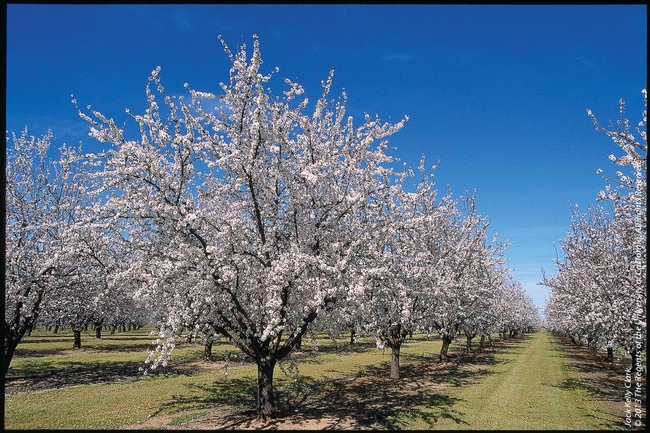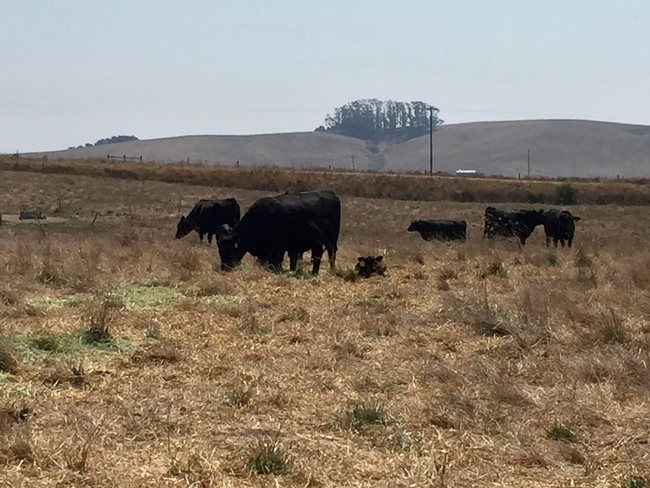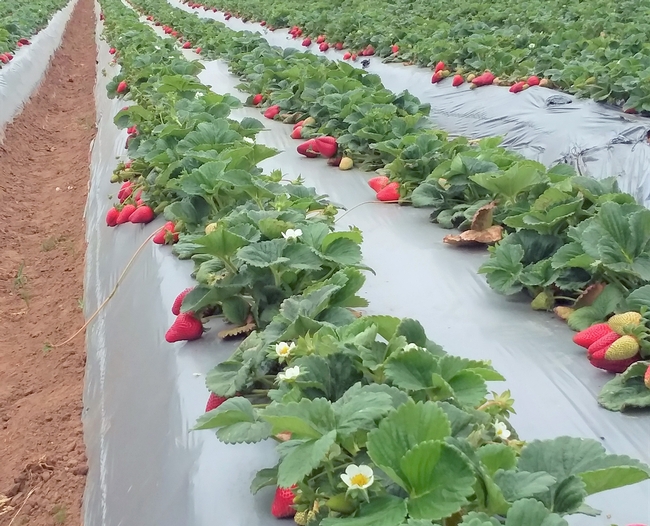Posts Tagged: Ellen Bruno
Leaks an untapped opportunity for water savings
Reducing leaks a cost-effective way to save urban water without draining utilities
Before a drop of treated water in California ever reaches a consumer's faucet, about 8% of it has already been wasted due to leaks in the delivery system. Nationally, the waste is even higher, at 17%. This represents an untapped opportunity for water savings, according to a study from the University of California, Davis.
The study, published in the journal Environmental Research Letters, is the first large-scale assessment of utility-level water loss in the United States. It found that leak reduction by utilities can be the most cost-effective tool in an urban water manager's toolkit, provided utility-specific approaches are used.
“When I first heard about ‘leaks' I thought it sounded boring, but leaks are a huge component of our water systems and have a larger opportunity than many other water-saving methods to make an impact,” said lead author Amanda Rupiper, a postdoctoral scholar with the UC Davis Center for Water-Energy Efficiency. “As the first state to regulate its water losses, a lot of eyes are watching California, and this is an opportunity to impact policy here and elsewhere.”
Amid a multiyear drought, the passage of Senate Bill 555 in 2015 made California the first in the nation and among the first in the world to require water utilities to regulate their water losses.
Be specific
Using data from more than 800 utilities across California, Georgia, Tennessee and Texas, the authors characterized water losses across the country. They developed a model to assess the economically efficient level of losses, and used that model to compare various water loss regulations and modeling approaches.
The study found that one-size-fits-all approaches to leak management are not effective, economical or equitable for utilities, which vary in size and resources. Uniform approaches could lead to the mismanagement of urban water losses. However, applying utility-specific performance standards can deliver a similar amount of water savings at a profit for both utilities and society.
“Regulations that impose a uniform standard across all utilities will result in water reductions that are too stringent in some cases, too relaxed in others, and too costly overall,” the paper concludes.
Saving drips without draining utilities
Ideally, no leaks would occur in a system. However, while some leaks are obvious and accessible, others can be harder and more cost-prohibitive for some utilities to find and repair. The authors' model assessed when utilities could save the most water for their dollar to find and fix leaks in the system.
They found that for the median utility, it is economically efficient to reduce water losses by 34.7%, or 100 acre-feet per year. The median cost of water savings from leak management is $277 per acre-foot — cheaper than most traditional water management tools, including conservation campaigns and rebate programs.
“It's cost-competitive to do this and should be part of the profile of how we manage our water,” Rupiper said. “We tend to think of leaks as being a little drip, but leaks are not inconsequential. Drips add up to big flows, and we can't ignore them anymore.”
The study's co-authors include Frank Loge, Joakim Weill and Katrina Jessoe of UC Davis, and Ellen Bruno of UC Berkeley.
Drought pushes California farmers and ranchers to adapt to a drier future
Despite historic drought, farms and ranches may receive normal revenue
Despite recent rains, the 2020–21 drought has been unusually severe. Low precipitation, coupled with high evaporation has affected irrigated crops and livestock pastures. Yet California farmers and ranchers are adept at adapting. Despite record-setting drought conditions and hundreds of thousands of acres left unplanted, California farms and ranches, as a whole, may generate normal revenue in 2021, according to the authors of a new special issue of ARE Update focusing on the drought.
The 2020 water year (which ran from October 2019 through September 2020), was dry and hot in California, with the warmest April through September since 1895. It was followed by the third driest year since 1895 – receiving about half of the average 20th century rainfall. Consecutive years with record-setting warm, dry conditions have led to higher evaporative demand. Some regions, particularly the Sacramento Basin, have been hit especially hard by this ongoing drought.
California farmers have adapted to the resulting water shortages by transferring scarce irrigation water to crops that have a higher expected net revenue per drop of water, such as fresh produce and nuts, while leaving some fields unplanted. Due to decreased pasture forage, livestock producers have had to cull mature cows and ship more feeder cattle out of state.
“The dairy industry has had strong production and good revenue, but has faced high feed costs in 2021 that reduced net returns,” said special issue co-editor Daniel Sumner, UC Davis agricultural economist.
The drought's impact on farm revenues and prices in California has varied across crops and regions. Agricultural production on the coast (e.g., vegetables, berries and wine grapes), which accounts for 25% of farm output, is less likely to experience irrigation cutbacks during a drought. Consumers will notice few major price increases for California produce because farmers shifted water to these high-revenue crops in which California specializes.
The special issue on drought concludes with an explanation of policy changes that have improved the California water system in the past and envisions how policy changes might mitigate impacts of future droughts. Legislation such as the Sustainable Groundwater Management Act (SGMA) will facilitate adapting to new climate realities by incentivizing water trading and banking, which allow water users to better allocate water across space and time.
Most groundwater agencies are still assessing the best way to bring their overdrafted groundwater basins into compliance with SGMA, with almost 80% planning to recharge groundwater through increasing supply (e.g., recharge or surface water trading) rather than reducing water demand (e.g., pumping restrictions).
“No one single solution exists for California's water challenges, but there's a lot of potential to make improvements to the current system,” said Ellen Bruno, special issue co-editor and UC Berkeley agricultural economist. “Improving the allocation of water through various policy changes could help water users adapt to water scarcity.”
To learn more about the impact of the ongoing drought on California agriculture, read the full Special Issue of ARE Update 25(1), UC Giannini Foundation of Agricultural Economics, online at https://giannini.ucop.edu/publications/are-update.
ARE Update is a bimonthly magazine published by the Giannini Foundation of Agricultural Economics to educate policymakers and agribusiness professionals about new research or analysis of important topics in agricultural and resource economics. Articles are written by Giannini Foundation members, including University of California faculty and Cooperative Extension specialists in agricultural and resource economics, and university graduate students. Learn more about the Giannini Foundation and its publications at https://giannini.ucop.edu.
ANR in the news May 1-15, 2020
How coronavirus is affecting the food supply
(Spectrum News) Jennifer Rufer, May 15
…Daniel Sumner, Executive Director of the University of California Agricultural Issues Center at UC Davis, tells Inside the Issues the meat shortage is a direct result of COVID-19. Because workers are typically in such close quarters, some are getting sick. The Centers for Disease Control and Prevention found 3 percent of workers in 100 meat processing plants have tested positive for the coronavirus, which, Sumner said, could mean the production won't be as robust as it used to be.
He said one of the bigger disruptions to the industry has been the impacts on cowboys and farmers who only provide one product.
“If you're a pig farmer, that's what you've got. The pigs are ready to go. So, everyday that you keep that hog, a 300 lb. hog, ready to go, you're losing money,” he said. “The same with cattle that are ready to go and there's no place to put them. That has shown in the price of cattle, and the price of hogs collapsing.”
The Surprising Backstory of Victory Gardens
(JSTOR Daily) Madeleine Compagnon, May 15
…Cultivating the earth as a response to moments of crisis dates back over a century, but not just as a relaxing activity. During World War I, writes Rose Hayden-Smith, a major Victory Garden movement promoted the idea of gardening as a civic duty. The goal was to increase food production on the home front, under the reasoning that the conservation of resources on the home front was key to victory on the battlefield. Garden propaganda was “striking in its use of military imagery,” according to Hayden-Smith's article. Poster campaigns often depicted “regiments” of women and children as “soldiers of the soil,” marching alongside U.S. troops.
https://daily.jstor.org/the-surprising-backstory-of-victory-gardens/
Revised Budget Features Significant Cuts to Close $54 Billion Deficit
(AgNet West) Brian German, May 15
…In his summary describing the state's economic position moving forward, Governor Newsom highlights federal assistance as playing a sizable role in structuring California's budget. Several reductions have been proposed if the state does not receive sufficient funding from the federal government, such as a 10 percent reduction in support for the University of California system. The UC Office of the President, UC PATH, and the UC Division of Agriculture and Natural Resources (UC ANR) would experience a decrease of more than $34 million in funding. New initiatives that were highlighted in the January budget, including the nearly $170 million in general funds for supporting a five percent UC base increase, have been now been withdrawn. The revised budget also eliminates another $3.6 million that would have supported a five percent base increase for UC ANR.
http://agnetwest.com/revised-budget-features-significant-cuts-54-billion-deficit/
$50 ribeye to go? Expect higher meat prices at Bay Area grocery stores and restaurants – (SFChronicle) Esther Mobley, May 14
…But while the supply of beef and pork in the U.S. has been down 10-15% in recent weeks, there is no long-term threat to the nation's meat supply, and already “it's creeping back up,” said Daniel A. Sumner, director of the University of California Agricultural Issues Center.
However, meat prices are also creeping up, and customers nationwide should expect their favorite cuts to be 10-20% more expensive than normal, Sumner added. In the Bay Area, the consumer price index for meat, poultry, fish and eggs rose 10.4% from February to April, according to the U.S. Bureau of Labor Statistics, compared to 5.5% for all types of groceries.
https://www.sfchronicle.com/food/article/Coronavirus-meat-shortage-We-won-t-run-out-of-15270789.php
UCCE sounds alarm on looming insect threat
(Farm Press) Jeannette Warnert, May 14
… “Spotted lanternfly is a major threat to apples, grapes, stone fruits, roses, landscape trees and the timber industry,” said Surendra Dara, UC Cooperative Extension entomology and biologicals advisor in San Luis Obispo, Ventura and Santa Barbara counties. “The agricultural industry and the public need to be looking out for this insect to prevent its migration and establishment in California.”
https://www.farmprogress.com/insects/ucce-sounds-alarm-looming-insect-threat
How to protect your home from disasters amplified by climate change
(Science) Mary Caperton Morton, May 13
…When it comes to climate-driven natural disasters, fires are as frightening as floods. In 2017 and 2018, California wildfires killed 147 people, burned 3.5 million acres and destroyed over 34,000 structures in two of the worst fire seasons on record. And wildfires are expected to become more severe across the West, says Max Moritz, a wildfire specialist at the University of California, Santa Barbara. “Warming temperatures are melting snow sooner and drying out vegetation so that we're already seeing longer fire seasons and more available fuel.”
…In densely built areas, the houses themselves can fuel fires. “You've probably seen aftermath photos where a fire has swept through a town and all the homes have burned, but there are still trees standing and green vegetation,” Moritz says. “That's what happens when the homes themselves are the fuel. It's not a land management problem where you should have cleared more. You can't thin the fuels because the homes were the fuel.”
https://www.sciencenews.org/article/how-to-protect-your-home-from-disasters-climate-change
Vine mealybug a menace in Monterey County
(Farm Press) Lee Allen, May 13
Larry Bettiga is urging growers to keep an eye out for vine mealybugs.
As the University of California Cooperative Extension Viticulture Farm Advisor from Monterey County observes, mealybugs are spreading leaf roll virus from site to site along the Central Coast.
Larry Bettiga is urging growers to keep an eye out for vine mealybugs.
As the University of California Cooperative Extension Viticulture Farm Advisor from Monterey County observes, mealybugs are spreading leaf roll virus from site to site along the Central Coast.
https://www.farmprogress.com/grapes/vine-mealybug-menace-monterey-county
New UC studies outline costs of producing irrigated pasture in the Sierra Nevada foothills
(YubaNet) May 12, 2020
Two new studies on the costs and returns of establishing and producing irrigated pasture in the Sierra Nevada Foothills have been released by UC Agriculture and Natural Resources' Agricultural Issues Center. Ranchers in Nevada, Placer and surrounding counties may find the cost estimates useful for planning.
USDA announces food distribution program, but will it help farmers?
(NPR Marketplace) Jasmine Garsd, May 11
…Now the U.S. Department of Agriculture has announced that starting this week, the Farmers to Families Food Box Program will begin distributing $1.2 billion in surplus food to communities across the country. Professor Daniel Sumner of the University of California, Davis, says the program aims to assist those who might not be covered by other programs, like food stamps. “They are homeless or they're not eligible in other ways. One of the attempts here is to get food to the poorest, most vulnerable people.”
Covid19 Pandemic Panic Gardening
(Food Chain Radio) Michael Olson, May 9
Guest: Missy Gable, Director University of California Master Gardener Program
https://metrofarm.com/michael-olson/covid19-gardening
4-H members embrace new communication technology
(Desert Review) Kayla Kirby, May 8
Imperial County 4-Hers have taken to the internet to connect with other members, leaders, and the community to share their experiences and current practices at home.
According to Program Director Anita Martinez, people think 4-H has gone dark after showing their animals at the fair. Martinez said that couldn't be further from the truth.
“During this time of year, everyone thinks 4-H is over because the fair is over. But this is when all of the other activities, projects, and events are going on,” said Martinez.
Vineyard Mechanization: Quality at a Distance
(Wine Business) W. Blake Gray, May 8
…"Vineyard size has increased in California due to consolidation," said S. Kaan Kurtural, associate specialist for cooperative extension viticulture at UC Davis Department of Viticulture & Enology. "Mean acreage is approaching close to 260 acres. It's hard to get to all these vineyards in a normal amount of time. The cost of labor has gone up: $15 an hour plus benefits, recently. Also, people don't want to work in vineyards anymore. And vineyards are a rural industry, not close to population centers. People have to be driven from populated areas."
https://www.winebusiness.com/news/?go=getArticle&dataId=230585
California Pistachios, Walnuts: Leaf-Out Problems – What's Going On?
(Ag Fax) Katherine Jarvis-Shean, May 8
Since mid-April, many advisors up and down the Valley have been receiving calls about unusual leaf-out in pistachio and walnut. The Sacramento Valley has certainly been experiencing this.
https://agfax.com/2020/05/08/california-pistachios-walnuts-leaf-out-problems-whats-going-on
California rice growers challenged by ammonia availability
(Farm Press) Todd Fitchette, May 7
…The good news for rice growers is they have choices. University of California rice Extension specialist Bruce Linquist compared aqua-ammonia to a granular urea fertilizer and found both performed similarly in terms of yield and nitrogen uptake. "To get these results, you must make sure that the urea is applied to a dry soil before flooding and it be managed so that it gets incorporated below the soil surface before planting (or banded as you do with aqua)," writes Linquist in the UC Rice Blog.
https://www.farmprogress.com/rice/california-rice-growers-challenged-ammonia-availability
Calif. ag shows strains under virus, shutdowns
(Farm Press) Tim Hearden, May 6
…Glenda Humiston, vice president of the University of California's Division of Agriculture and Natural Resources, said the increased reliance on web-based working, communication and education emphasized the need for improved rural broadband internet service. The university is considering installing signal towers at its Cooperative Extension offices and facilities that growers can access for automated field work, she said.
“We've known for years that rural areas are not well served,” Humiston said. “California is a leader in emerging technology … but the reality is a big chunk of California is still underserved or unserved (by broadband).
“We are having some luck in developing public-private partnerships,” she said, “but the reality is public investment is going to be critical for this.”
https://www.farmprogress.com/farm-operations/calif-ag-shows-strains-under-virus-shutdowns
Welcome to the Age of Digital Agriculture
(Growing Produce) David Eddy, May 6
Growers have traditionally relied on scouts to get the information they need to make decisions. But there are a couple of problems with that. First, the data gathered isn't always 100% reliable. Second, labor costs are rising – that is, if growers can even source the increasingly scarce labor they need.
Researchers at the Digital Agriculture Laboratory at the University of California, Davis, are trying to change that. Dr. Alireza Pourreza, a University of California Cooperative Education Specialist of Agricultural Mechanization, is leading a project to employ remote sensing for nutrient content detection in table grapes.
https://www.growingproduce.com/fruits/welcome-to-the-age-of-digital-agriculture/
Potential for meat shortages may go away sooner than later
(KTVU) Tom Vacar, May 6
…To avoid meat hoarding, many grocers are limiting purchases. UC Davis Professor Daniel Sumner is a renowned agricultural economist.
"As consumers, we're probably gonna pay a little more and/or another way the stores will say, 'Well, we don't want to raise our prices too much, so you'll only buy two packages,'" said Professor Sumner.
Coronavirus has shut down numerous meat packing facilities causing a shortage. Beef, pork and chicken farmers are paying a huge price. "Those folks are in trouble because they've got big supplies that can't get processed," said Sumner. As closed plants slowly reopen to workers, it will not be business as usual.
"You give them their social distance at work, that means you have to slow down everything. You have fewer people on the line. It all goes slower," said Sumner.
To assure a reliable supply, much of the nation's wholesale meat is purchased far in advance of delivery at a price determined by the futures market. With tens of millions of layoffs, supply and demand are uncertain.
"So the slaughter people are saying, 'We're not gonna pay much for those pigs three or four months from now.' And the farmer says, 'Well, in that case, it's not worth putting a whole bunch of corn and soybeans in them,'" said Sumner.
… For now, this problem seems to be short-lived. "I certainly wouldn't encourage anyone to say, 'Well, we're running out of meat.' because we're not." said Professor Sumner.
https://www.ktvu.com/news/potential-for-meat-shortages-may-go-away-sooner-than-later
COVID-19 exposes U.S. meat supply's dependence on a few large plants
(Marketplace) Mitchell Hartman, May 6
…We've got plenty of cattle and hogs, but there's a hold-up slaughtering and butchering them with big plants shut down, says University of California, Davis, agricultural economist Dan Sumner.
“We're processing 20% or 30% less meat than we would have done a year ago,” Sumner said.
…But Sumner says industry consolidation hasn't made meat supplies more vulnerable to the virus.
“There's no particular reason to think that it's more likely to hit a large plant outside of Sioux Falls than 20 or 30 small plants circled around Sioux Falls,” he said.
https://www.marketplace.org/2020/05/06/covid-19-meat-shortages-processing-plants-grocery-stores/
Food Availability is ‘Not the Thing to Worry About' During Pandemic
(AgnetWest) Brian German, May 4, 2020
Of all the issues that have arisen related to the coronavirus pandemic, food availability should not be a concern. Domestic agricultural production continues to progress, despite complications within the supply chain while it adjusts to market changes. However, Agricultural Economist at UC Davis Dan Sumner explained there may be concerns moving forward as it relates to consumer purchasing power and eating trends.
“Higher-end items will struggle. The ones that people eat as sort of a splurge, well there will be less of that going on. Whether that's eating out, food away from home, more people packing a sandwich rather than eating at the café, going out to dinner less often, those sorts of things,” Sumner told AgNet West. “Then on food at home; ‘less steak and more hamburger,' if I can put it that way.”
http://agnetwest.com/food-availability-is-not-the-thing-to-worry-about-during-pandemic/
Is Integrated Pest Management the future of Agriculture?
(Fresh Fruit Portal) Thomas Grandperrin, May 5
Since its formalization as a term in the late 1960s, Integrated Pest Management (IPM) is a strategy that has been adopted in most parts of the world. Surendra Dara, who is an entomologist with a specialization in microbial control and IPM currently working as a University of California Cooperative Extension Advisor, is one of its most active promoters.
Coronavirus and Agriculture
Food Chain Radio) Michael Olson, May 2,
Guest: Doug Fine – Dr. Ellen Bruno Cooperative Extension Specialist, UC Department of Agriculture and Resource Economics & Co-author: “The Coronavirus and The Food Supply Chain”
https://metrofarm.com/michael-olson/coronavirus-and-agriculture/
Farm City Newsday Friday, 05-01-20
(Farm City Newsday) Brian German, May 1
…DANIEL SUMNER: If you think of middle-income people where one of two earners in a family are out of a job, well, that really takes a hit. It doesn't mean you don't eat, but what it does do is change what you eat. Higher end items will struggle. The ones that people eat as a splurge, well, there will be less of that going on. Whether that's eating out or more people packing a sandwich rather than eating at a café or going out to dinner less often. On food at home, less steak and more hamburger. All of this will shake out into farm prices, as it always does, and no one has strong projections yet.
http://agnetwest.com/farm-city-newsday-friday-05-01-20/







